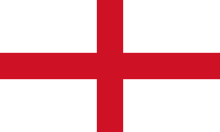




Designed by Nigel G Wilcox
Everything For The Metal Detectorist - National Flags


Powered By Sispro1
British, St George's Cross - Flag
Genoan origin
Some historians believe that the St George's Cross was adopted from the flag of Genoa , which dates back to 1096. The Genoese flag was adopted from the personal flag of St. Ambrose, the Fourth Century Bishop of Milan who was a key figure in the development of Christianity in the West. St. Ambrose's cross had become a symbol of Milan, then the wider areas of Northern Italy. (Because it was a common symbol in the region, it was the flag of the Lombard League, a coalition of city states including both Milan and Genoa that opposed Frederick Barbarossa in the 12th and 13th Century.) Genoa's patron saint was St. George, and its vast trading fleet carried the association between the flag and the Saint across the ports of Europe and the Mediterranean Sea.
Prince Edward, Duke of Kent, supports this theory:
"The St. George's flag, a red cross on a white field, was adopted by England and the City of London in 1190 for their ships entering the Mediterranean to benefit from the protection of the Geonoese fleet. The English Monarch paid an annual tribute to the Doge of Genoa for this privilege."
Middle Ages
From about 1277, due to already widespread use, St George's cross officially became the national flag of England. The three lions remained the coat of arms and flag of the king.
After the dynastic union of England and Scotland in 1603 (the so-called "Union of the Crowns"), a combined British flag was created in 1606, initially for maritime display, later restricted to the King's ships, by combining St George's Cross with the St Andrew's Cross. The St George flag remained the flag of England for other purposes until the Acts of Union 1707. At the union, the first Union Flag become official for all purposes in the new Kingdom of Great Britain.
Modern usage
St George's flag flying on Leeds Town Hall.
Nevertheless, in heraldry the St George's Cross continued to be used in the fly of standards in English grants of arms. It is still used to represent England and by those who wish to show pride in England specifically.
The flag of St George is also the rank flag of an Admiral in the Royal Navy , and civilian craft are forbidden to fly it. However, ships which took part in the rescue operation at Dunkirk during World War II are allowed to fly it as a jack.
Churches belonging to the Church of England (unless for special reasons another flag is flown by custom) may fly the St George's Cross. The correct way (since an order from the Earl Marshal in 1938) is for the church to fly the St George's cross, with the arms of the diocese in the left-hand upper corner of the flag.
The flag of St George has since the late 20th century enjoyed a resurgence in popularity partly due to football-inspired nationalism, and also in response to the devolution movements in Scotland and Wales.
During the 2010 World Cup the UK Prime Minister, David Cameron, told Parliament that the flag would fly above his official residence at "no extra cost to the tax payer" whilst England played in the contest.
The Flag of England is the St George's Cross (heraldic blazon: Argent, a cross gules). The red cross appeared as an emblem of England in the Middle Ages, specifically during the Crusades (although the original symbol used to represent English crusaders was a white cross on a red background) and is one of the earliest known emblems representing England. It also represents the official arms of the Most Noble Order of the Garter, and it achieved status as the national flag of England during the sixteenth century.
Saint George was adopted as the patron saint of England in the thirteenth century, and the legend of Saint George slaying a dragon dates from the twelfth century.
Some historians believe that the St George's Cross was adopted from the flag of Genoa , which dates back to 1096. The Genoese flag was adopted from the personal flag of St. Ambrose, the Fourth Century Bishop of Milan who was a key figure in the development of Christianity in the West. St. Ambrose's cross had become a symbol of Milan, then the wider areas of Northern Italy. (Because it was a common symbol in the region, it was the flag of the Lombard League, a coalition of city states including both Milan and Genoa that opposed Frederick Barbarossa in the 12th and 13th Century.) Genoa's patron saint was St. George, and its vast trading fleet carried the association between the flag and the Saint across the ports of Europe and the Mediterranean Sea.
Prince Edward, Duke of Kent, supports this theory:
"The St. George's flag, a red cross on a white field, was adopted by England and the City of London in 1190 for their ships entering the Mediterranean to benefit from the protection of the Geonoese fleet. The English Monarch paid an annual tribute to the Doge of Genoa for this privilege."
Middle Ages
From about 1277, due to already widespread use, St George's cross officially became the national flag of England. The three lions remained the coat of arms and flag of the king.
After the dynastic union of England and Scotland in 1603 (the so-called "Union of the Crowns"), a combined British flag was created in 1606, initially for maritime display, later restricted to the King's ships, by combining St George's Cross with the St Andrew's Cross. The St George flag remained the flag of England for other purposes until the Acts of Union 1707. At the union, the first Union Flag become official for all purposes in the new Kingdom of Great Britain.
Modern usage
St George's flag flying on Leeds Town Hall.
Nevertheless, in heraldry the St George's Cross continued to be used in the fly of standards in English grants of arms. It is still used to represent England and by those who wish to show pride in England specifically.
The flag of St George is also the rank flag of an Admiral in the Royal Navy , and civilian craft are forbidden to fly it. However, ships which took part in the rescue operation at Dunkirk during World War II are allowed to fly it as a jack.
Churches belonging to the Church of England (unless for special reasons another flag is flown by custom) may fly the St George's Cross. The correct way (since an order from the Earl Marshal in 1938) is for the church to fly the St George's cross, with the arms of the diocese in the left-hand upper corner of the flag.
The flag of St George has since the late 20th century enjoyed a resurgence in popularity partly due to football-inspired nationalism, and also in response to the devolution movements in Scotland and Wales.
During the 2010 World Cup the UK Prime Minister, David Cameron, told Parliament that the flag would fly above his official residence at "no extra cost to the tax payer" whilst England played in the contest.
The Flag of England is the St George's Cross (heraldic blazon: Argent, a cross gules). The red cross appeared as an emblem of England in the Middle Ages, specifically during the Crusades (although the original symbol used to represent English crusaders was a white cross on a red background) and is one of the earliest known emblems representing England. It also represents the official arms of the Most Noble Order of the Garter, and it achieved status as the national flag of England during the sixteenth century.
Saint George was adopted as the patron saint of England in the thirteenth century, and the legend of Saint George slaying a dragon dates from the twelfth century.
Flag of Genoa


Flag of England

Courtesy of Wikipedia
England
Irish Flag
Flag Menu
Union Flag
Copyright All Rights Reserved by Nigel G Wilcox E-Mail: ngwilcox100@gmail.com
The Paragon Of Metal Detecting
& Archaeology
& Archaeology
5. Menu
Pages
Member NCMD

12.07.20
Happy Birthday England, we are one thousand and eighty seven years old today.
Today is the anniversary of King Athelstan who realised the dream of the Venerable Bede and completed the mission of The Royal House of Wessex to convert England into a single united state.
Leaving the EU is no biggy is it when you think.
We are the home of one of the earliest democratic parliaments, the rule of law the police force and all things that make society function.
happy Birthday to all of us
Happy Birthday England, we are one thousand and eighty seven years old today.
Today is the anniversary of King Athelstan who realised the dream of the Venerable Bede and completed the mission of The Royal House of Wessex to convert England into a single united state.
Leaving the EU is no biggy is it when you think.
We are the home of one of the earliest democratic parliaments, the rule of law the police force and all things that make society function.
happy Birthday to all of us




















